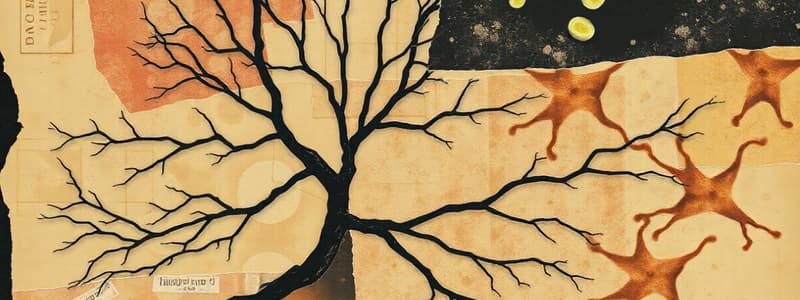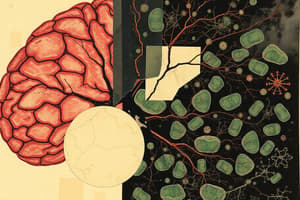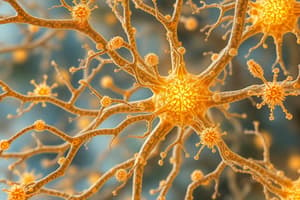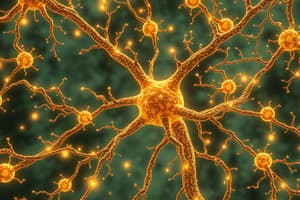Podcast
Questions and Answers
What is the origin of nervous tissue in embryonic development?
What is the origin of nervous tissue in embryonic development?
- Mesoderm
- Notochord
- Ectoderm (correct)
- Endoderm
Which of the following statements about neurons is true?
Which of the following statements about neurons is true?
- Neurons have long axons and dendrites. (correct)
- Neurons primarily secrete hormones.
- Neurons are very small and non-excitable.
- Neurons lack axons.
What role does the notochord play in nervous system development?
What role does the notochord play in nervous system development?
- It creates the epithelial layer of the skin.
- It serves as the primary signaling structure for muscle development.
- It induces the differentiation of ectoderm into the neural plate. (correct)
- It becomes part of the peripheral nervous system.
What percentage of tumors does epithelium account for?
What percentage of tumors does epithelium account for?
Which type of tissue is primarily responsible for the transmission, reception, and integration of electrical impulses?
Which type of tissue is primarily responsible for the transmission, reception, and integration of electrical impulses?
What is the primary function of the nervous system?
What is the primary function of the nervous system?
Which of the following statements is true regarding the characteristics of neurons?
Which of the following statements is true regarding the characteristics of neurons?
What comprises the Central Nervous System (CNS)?
What comprises the Central Nervous System (CNS)?
What type of glial cells are responsible for producing myelin in the Peripheral Nervous System (PNS)?
What type of glial cells are responsible for producing myelin in the Peripheral Nervous System (PNS)?
Which part of a neuron is primarily responsible for receiving signals?
Which part of a neuron is primarily responsible for receiving signals?
What does the term 'perikaryon' refer to in a neuron?
What does the term 'perikaryon' refer to in a neuron?
Which of the following correctly describes the role of microglial cells?
Which of the following correctly describes the role of microglial cells?
What is the primary difference between the sympathetic and parasympathetic divisions of the autonomic nervous system?
What is the primary difference between the sympathetic and parasympathetic divisions of the autonomic nervous system?
What is the primary function of Nissl bodies in neurons?
What is the primary function of Nissl bodies in neurons?
Which type of neuron is characterized by having one axon and one dendrite?
Which type of neuron is characterized by having one axon and one dendrite?
What role do astrocytes play in the central nervous system?
What role do astrocytes play in the central nervous system?
What characterizes a unipolar neuron during embryogenesis?
What characterizes a unipolar neuron during embryogenesis?
Which neuron type carries impulses from sensory receptors to the central nervous system?
Which neuron type carries impulses from sensory receptors to the central nervous system?
Which cell type is responsible for lining the cavities of the brain and producing cerebrospinal fluid?
Which cell type is responsible for lining the cavities of the brain and producing cerebrospinal fluid?
What structure in the neuron is known to lack rough endoplasmic reticulum and Nissl substance?
What structure in the neuron is known to lack rough endoplasmic reticulum and Nissl substance?
Which of the following cells are classified as microglia?
Which of the following cells are classified as microglia?
Which of the following compounds is most likely to cross the blood-brain barrier?
Which of the following compounds is most likely to cross the blood-brain barrier?
What function do oligodendrocytes serve in the central nervous system?
What function do oligodendrocytes serve in the central nervous system?
Which characteristic distinguishes myelinated nerve fibers from unmyelinated nerve fibers?
Which characteristic distinguishes myelinated nerve fibers from unmyelinated nerve fibers?
Classifying synapses by nature, which would be categorized as a chemical synapse?
Classifying synapses by nature, which would be categorized as a chemical synapse?
Which of the following sensory receptors would best respond to changes in temperature?
Which of the following sensory receptors would best respond to changes in temperature?
What is a primary role of microglia within the central nervous system?
What is a primary role of microglia within the central nervous system?
Which of the following is NOT classified as a type of sensory nerve ending?
Which of the following is NOT classified as a type of sensory nerve ending?
What specific type of synapse connects an axon to another axon's terminal?
What specific type of synapse connects an axon to another axon's terminal?
Flashcards
Nervous Tissue Origin
Nervous Tissue Origin
Nervous tissue develops from the ectoderm, the outermost embryonic layer, starting in the third week of development.
Nervous Tissue Function
Nervous Tissue Function
Nervous tissue transmits, receives, and integrates electrical signals.
Neurons
Neurons
Neurons are specialized cells with long processes (axons and dendrites) for transmitting signals.
Synapse
Synapse
Signup and view all the flashcards
Nervous Tissue Distribution
Nervous Tissue Distribution
Signup and view all the flashcards
Nervous system function
Nervous system function
Signup and view all the flashcards
Neuron irritability
Neuron irritability
Signup and view all the flashcards
Neuron conductivity
Neuron conductivity
Signup and view all the flashcards
CNS (Central Nervous System)
CNS (Central Nervous System)
Signup and view all the flashcards
PNS (Peripheral Nervous System)
PNS (Peripheral Nervous System)
Signup and view all the flashcards
Neuron structure (body)
Neuron structure (body)
Signup and view all the flashcards
Neuron process types
Neuron process types
Signup and view all the flashcards
Nervous system information transfer
Nervous system information transfer
Signup and view all the flashcards
Blood-Brain Barrier
Blood-Brain Barrier
Signup and view all the flashcards
Lipid-Solubility
Lipid-Solubility
Signup and view all the flashcards
Oligodendrocytes
Oligodendrocytes
Signup and view all the flashcards
Microglia
Microglia
Signup and view all the flashcards
Schwann Cells
Schwann Cells
Signup and view all the flashcards
Nodes of Ranvier
Nodes of Ranvier
Signup and view all the flashcards
Excitatory Synapse
Excitatory Synapse
Signup and view all the flashcards
Nissl bodies
Nissl bodies
Signup and view all the flashcards
Dendrites
Dendrites
Signup and view all the flashcards
Axon
Axon
Signup and view all the flashcards
What is unique about the axon hillock?
What is unique about the axon hillock?
Signup and view all the flashcards
Unipolar neurons
Unipolar neurons
Signup and view all the flashcards
Bipolar neurons
Bipolar neurons
Signup and view all the flashcards
Pseudounipolar neurons
Pseudounipolar neurons
Signup and view all the flashcards
Multipolar neurons
Multipolar neurons
Signup and view all the flashcards
Study Notes
Nervous Tissue Overview
- Nervous tissue is specialized for transmitting, receiving, and integrating electrical impulses.
- It comprises the central nervous system (CNS) and peripheral nervous system (PNS).
- The CNS includes the brain and spinal cord.
- The PNS comprises nerves, sensory ganglia, and autonomic ganglia.
Types of Neural Cells
- Neurons: Responsible for transmitting information through electrical impulses.
- Glial cells: Support and nourish neurons;
- Astrocytes: (CNS) form the blood-brain barrier (BBB) and control the chemical environment.
- Oligodendrocytes: (CNS) produce myelin sheaths around nerve fibers.
- Ependymal cells: (CNS) line cavities of the brain and spinal cord, producing cerebrospinal fluid.
- Microglia: (CNS) are spider-like phagocytes; dispose of debris.
- Schwann cells: (PNS) produce myelin sheaths around nerve fibers.
- Satellite cells: (PNS) surround cell bodies of neurons in sensory ganglia.
Neuron Structure
- Cell body (perikaryon): Contains the nucleus and is the metabolic center.
- Processes (dendrites and axon): Extend from the cell body.
- Dendrites: Conduct impulses toward the cell body.
- Axon: Conducts impulses away from the cell body.
- Nerve endings (synapses): Structures at the end of axons that connect with other neurons or target cells.
Neuron Classifications (Structural)
- Unipolar: Found during early development; one axon.
- Bipolar: One axon and one dendrite.
- Pseudounipolar: Short single process leaving the cell body.
- Multipolar: Many extensions from the cell body (most common).
- Axons and dendrites differ in structure and function.
Classifications of Neurons (Functional)
- Sensory (afferent): Carry impulses from sensory receptors to the CNS.
- Motor (efferent): Carry impulses from the CNS to effector cells (muscles and glands).
- Interneurons (association neurons): Connect sensory and motor neurons; make up most of the CNS.
Neuron Processes and Synapses
- Axons (single or branching per neuron) conduct impulses away from the cell body.
- Dendrites conduct impulses towards the cell body; they branch extensively allowing reception of impulses from many sources.
- All neurons end in nerve endings (synapses) that connect with other neurons or target cells.
Synapse Structure
- Synapses are specialized regions of contact between neurons.
- There are two types: chemical and electrical.
- Neurotransmitters are chemicals released from the axon at synapses and transmit the nerve impulse across the synapse.
Sensory Nerve Endings (Receptors)
- Classified by location (exteroceptors, interoceptors, proprioceptors).
- Classified by stimulus type (chemoreceptors, mechanoreceptors, photoreceptors, thermoreceptors).
- Classified by structure (free nerve endings, hair follicle endings, encapsulated endings - tactile corpuscle of Meissner, corpuscle of Pacini, Ruffini endings, muscle spindle, Golgi tendon organ).
- These structures are located throughout the body and enable the sensory aspects of function.
Nervous Tissue Activity
- Nervous tissue is involved in reception, processing, and transmission of information throughout the body.
- Neural pathways are routes of information transmission, encompassing sensory and motor pathways.
Studying That Suits You
Use AI to generate personalized quizzes and flashcards to suit your learning preferences.




